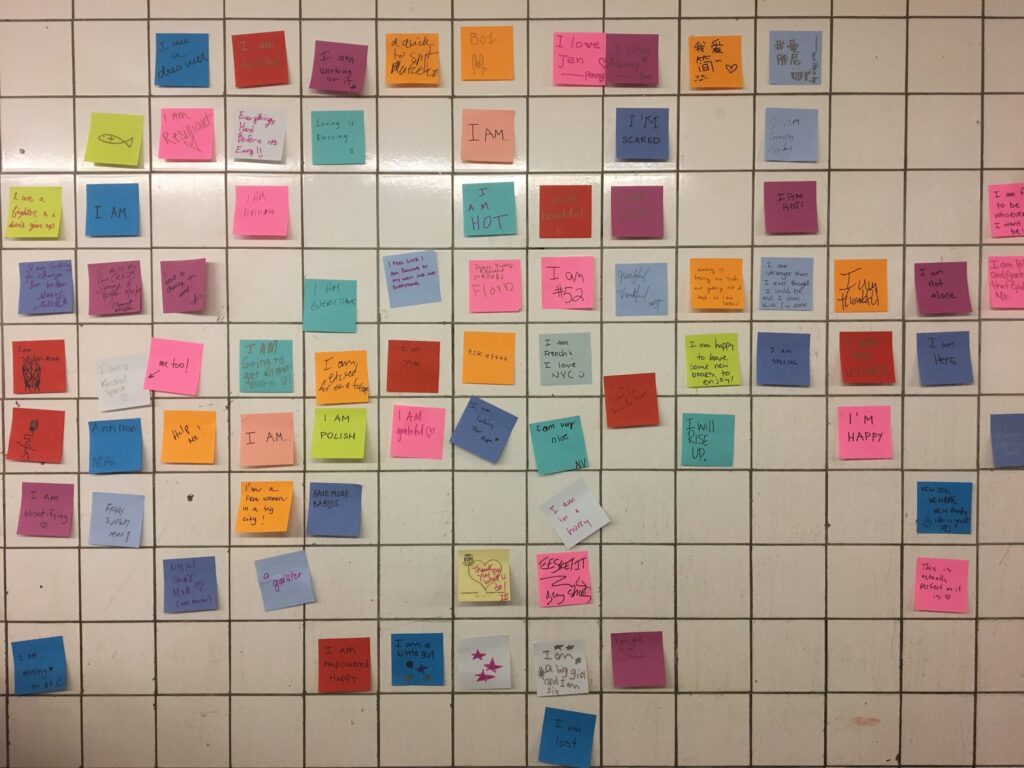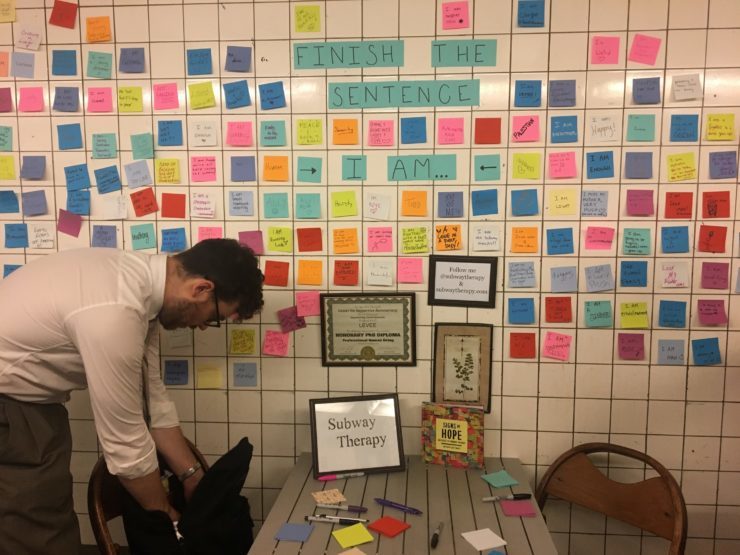The 14th Street subway station was hot and noisy with gossip and foot traffic, with a lingering scent of something musty I couldn’t immediately identify. I could hear mediocre performers play instruments in the distance, the subway’s automated announcements weaving into the sounds of subway trains screeching. My eyes scanned the dingy subway tiles until I found a splash of bold checkered color. As soon as I approached, I noticed myself relaxing. The man standing there greeted me with a cheerful smile and a quick hug.
Reading the notes feels like one is eavesdropping into people’s personalized word-of-the-day. A sea of fragmented thoughts held together with weak glue.
In the otherwise sweaty underground maze leading to the L train, Matthew “Levee” Chavez is a cool presence. He is always dressed in a neatly pressed shirt and tie. His tousled hair is swept to the side, and his dark-framed glasses makes you think that he is either a young-ish woke philosophy teacher or a member of a Brooklyn-based indie band. In reality, he is a loose combination of those things. He is unofficially known as New York’s “Subway Therapy guy,” but chooses to be called “Levee,” which is defined as “an embankment along a river that prevents flooding during inclement weather.”
It all started after the 2016 presidential election. When Donald Trump, a native New Yorker, won the presidency, Levee came up with the idea to give locals and tourists a chance to jot down quick notes and stick them on the wall, creating a handmade collage of their hopes and fears.
Since then, he’s been a staple in the underground. You probably saw him on the news or on your Instagram feed—he was the guy who gave out the “sticky notes…spontaneously spreading like rainbow-colored ivy” all over Union Square after the election. On average, Levee would sit there for about eight hours, his little section affectionately known as the “Subway Therapy” space. (Although he has a mock honorary certificate framed on the wall, he’s not a licensed therapist and makes that clear to anyone who asks.)
Nearly a year later, Levee swipes his MetroCard to get into the underground but doesn’t rush to any subway platform. He calmly takes out his foldable table, two chairs, a few pads of neon sticky notes, colored pens, his business cards and waits.
His “office location” changes from time to time, but on a recent day, he was stationed along the vast hallway of the 14th Street station. We sat together for about an hour as dozens of people rushed by us. Many sprinted by with indifferent glances, while others curiously looked but kept moving. About a dozen snapped photos without uttering a word. But equally as many reached out for a sticky note and asked, “Can I?”

Levee had put up the instigating words “I am” and asked passers-by to finish the sentence. “I am confused on what’s next.” “I am happier now.” “I am going to dance my ass off tonight.” “I am running late.” He would often look up and watch the stickies form a morphing wave of mosaic tiles, full of love and hate notes to the city and to one another—and ourselves.
Reading the notes feels like one is eavesdropping into people’s personalized word-of-the-day. A sea of fragmented thoughts held together with weak glue. Some choose to decorate their notes with elaborate and intricate messages, others are riddled with typos and ink smudges. There is no spellcheck or autocorrect. I asked which note he wrote on that day, and he said, “Thirsty.”
Levee says he doesn’t do this for the money; in fact, he won’t accept tips at all. He wanted to prove to himself and to others that some good things in life are free. Occasionally, he accepts a granola bar, a bagel or a water bottle if someone insists.
I’d bumped into Levee a few other times, and in every single interaction, he seemed genuinely at peace and always had a hug and an attentive ear ready. It would never take long to find a stressed commuter stop by and literally stick their hopes and fears on the subway walls; each a tiny fingerprint in the pulse of the city. Some pressed hard on the paper, some used lipstick on their mouths to produce a kiss mark. While we are used to typing, this is a very old-fashioned and tangible experience. Touching a piece of paper, stripping it from the pad and placing it on the wall seems like what many of us New York transplants have done. Levee, a native Californian, essentially did just that when he plucked himself from his hometown and came solo to the city.
He says post-its or sticky notes were always around him growing up. His father, a romantic, used to leave sticky notes for his mother with mini love notes. His mother, a teacher, used them with her students.
He sticks the notes on top of each other each night and stores them in boxes at his Brooklyn residence. The New York Historical Society has selected a stack of these notes to be preserved for future display. But he has found a way to celebrate these notes in a more organized way, by compiling many into his first book. Aptly named, “Signs of Hope: Messages from Subway Therapy,” will be published this month. The book, which has a thoughtful introduction and a creative toolkit to suggest ways people could contribute to the community positively, is filled with scanned images of select notes, is available for pre-order now. Levee will donate a portion of the book’s proceeds to the ACLU, which supports free speech, and to Win, which provides shelter to the homeless in NYC.
In his book’s dedication, he writes: “This book is dedicated to all the people who wrote something, volunteered, smiled, laughed, cried, or in any way participated in Subway Therapy.”
Realistically, Levee knows that this communal art experience won’t move mountains or shift perspectives. But he aims to provide a colorful space in which New Yorkers can slow down and appreciate the simple things in life—like using an inexpensive colorful piece of paper, a pen and a thought. There is no battery required or App to download.
It’s also probably the least expensive kind of therapy one could ever get in the city. Like the book’s title, these are not solutions or laws—just literal signs of hope.

Are you a therapist?
No, but I do have a fake certificate that I hang up each time. I like to tell people that something that is heavy for you might not be heavy for me. I’m a good listener. I didn’t pick the name—I started out as the “Secret Keeper” but heard over and over that people thought it felt like therapy for them. So I changed the name.
Why sticky notes?
I feel like I’m feeding Union Square and the underground, like a gardener. It is the most easily accessible and nostalgic tool. We all know what to do when we see a sticky note; we don’t need anyone to explain it. One of the most common things people ask when they see the notes is, “Is it free?” Yes, it is. The company 3M sent a box during the election, which I’m still using now. If I need more, I just buy cheap ones if I have to.
Since Subway Therapy is payment-free, how are you surviving in NYC financially?
On this topic, I find it fascinating that people are eager to hear how artists make money. I'm still not sure how I feel about talking about it. For the most part I respond playfully, but I think that inquiry suggests a huge problem in the way our society values certain occupations. On occasion, I have visitors who belligerently don't believe that I make money doing Subway Therapy. If I wasn't doing Subway Therapy I would be in the voiceover world, which I plan to get more into it next year when I have more time.
What are some of the other hats that you wear?
Sometimes I do events that require my full attention, but I'm not always in the subway full time. I make money in the way artists tend to make money: Donations, sponsorships, book sales and events. Lectures at universities generally keep me going as a full-time advocate for the importance of interactive and immersive experiences that help us to feel less stress and more connected in a divided time. Maybe students at Harvard could benefit from a lecture about that?
"I feel like I’m feeding Union Square and the underground, like a gardener. It is the most easily accessible and nostalgic tool. We all know what to do when we see a sticky note; we don’t need anyone to explain it."
How do you stay motivated to keep doing this, week after week, despite the news cycle remaining relatively the same?
It is very special still. I try to be here to make people feel comfortable. I get to access people in New York in a way that is really uncommon. I moved to New York from California on a really late flight and watched the sunrise. I arrived with zero money, nowhere to live, a backpack, some luggage and a guitar. It is such a cliché. I stared out the window of the subway—it was one of those above ground—and it felt like my life was starting. I spent the first months in New York walking dogs, bartending and failing at being a voiceover actor. It’s really hard to see something unique in New York now. My biggest compliment is when a native New Yorker called me a “polar bear,” a term reserved for those who do something so unique and off-the-wall. She said, “I’ve lived in New York my whole life and have never seen this.” New York opened up when I saw that first sunrise.
You’ve now moved Subway Therapy beyond New York, to places across the country in cities like San Francisco and internationally to places like Belgium and Scandinavia. How are the notes different?
People tend to talk about the same things in the notes: Love, hope and fears. It’s funny, but if you take a step towards the table [gesturing away from the subway hallway]—you are not in the subway anymore. Just a few feet away from this and you’re in the subway. Here, near the table, you are immersed. It’s a fabrication of a therapist’s office. Sitting here, you can share. It’s also cheaper than real therapy. So many people come to me and complain about their therapists! When I came to New York, I didn’t know how this was going to go, but now I am not just a person in New York. I am a part of the subway. I am a part of the infrastructure, a piece of the actual city. I didn’t intend to be a New York figure. I haven’t met HONY yet [Humans of New York, who tells stories of New Yorkers through photos], but it would be really cool if he stopped by.



